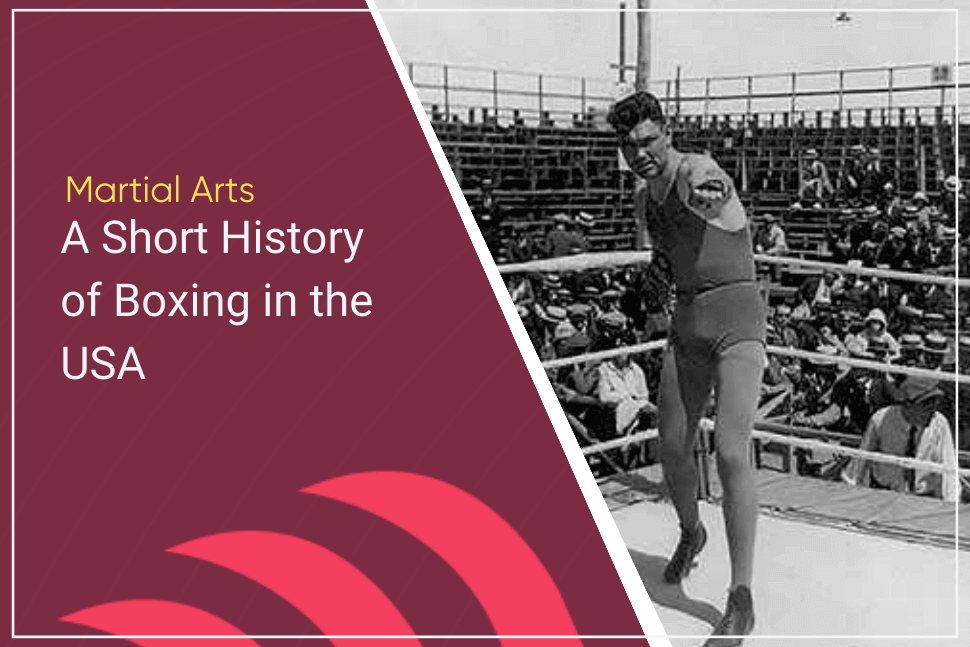The sport of boxing has been an integral part of American culture for well over a hundred years. Even during low points in boxing history, plenty of men and women still took great interest in watching and participating. The sport was never going to disappear, and it never will.
The sweet science has catalyzed new interests in many people and kept countless others from going to or returning to prison. There is much more to it than just two people hitting each other in the face. It takes a lot of practice to develop the agility, quickness, guile, and techniques necessary to be successful in the ring.
It is said that Irish immigrants introduced boxing to the United States as they migrated to the Northeast throughout the 1860s and 1870s, gaining prominence in cities like New York and Boston during the last quarter of the 19th century, and fought with only bare knuckles.
There were no state-sanctioned bare-knuckle fights; bouts were organized and champions were recognized by the popular men’s lifestyle magazine National Police Gazette. In 1867, the first set of codified boxing rules to mandate the use of gloves was established in London, England, known as the Queensberry Rules, and was adopted in the United States in 1889.
John L. Sullivan was the last bare-knuckle heavyweight champion and the first with gloves under the new rules, defeating James Corbett in 1892.
As the sport gained more prominence, the Amateur Athletic Union (AAU) was established on January 21, 1888. The AAU held its first event in April, overseeing boxing, fencing, and wrestling competitions. In 1900, New York state passed the heavily restrictive Lewis Law, whose real aim was to effectively eradicate the sport entirely. The new law effectively banned prizefighting and other fights unless the two competitors belonged to an exclusive athletic club and were held in private venues. Fortunately, states in the western United States were a lot more lenient and tolerable with allowing boxing matches to take place, which played a major role in keeping the sport alive. During this era, champions were determined by the popular consensus expressed in newspapers.
Boxing in the 1920s
In 1920, the Lewis Law was repealed and replaced by the Walker Law, which established the New York State Athletic Commission (NYSAC) and implemented various rules and regulations that were in the best interest of the fighter’s safety and to make the sport more palatable towards a broader audience. Changes included fighting 15 rounds for title fights, mandated medical personnel to be present for the entire show, and banning certain moves like head butting. The following year, the National Boxing Association (NBA) was established which comprised 13 states. The NBA later changed its name to the World Boxing Association (WBA) in 1962 and is one of the leading boxing promotions in the world.
Boxing gained immense popularity because of the new changes. The sport rose to prominence once radio stations began broadcasting the fights, and it was typical to see several thousand people in attendance for major events. Jack Dempsey, who was heavyweight champion from 1919 to 1926, became a household name and was known as one of the Big Five in American sports, joining the likes of baseball player Babe Ruth, tennis player Bill Tilden, golfer Bobby Jones, and football player Red Grange. Boxing was quickly becoming mainstream and accepted as a legitimate sport in the public eye.
In 1923, Chicago Tribune sports editor Arch Ward was instrumental in creating the Golden Gloves Of America. The organization was initially created for holding competitions between amateur fighters from Chicago and New York, where the sport was most popular. It later changed its name in 1962 to the National Golden Gloves and remains the pinnacle of amateur boxing competition.
Boxing in the 1930s
Just as the sport started gaining in popularity, it took a major hit after the stock market crash in 1929. As the country went through a depression for the rest of the decade, professional boxers also experienced a massive reduction in payouts due to the crippled economy. However, thanks to a highly competitive heavyweight division, the sport was kept alive by entertaining fighters such as Max Schmeling, Max Baer, and Joe Louis, who became champion in 1937 and held the title until his retirement in 1949. Louis is still the only boxer in any weight class to hold a world title for the entirety of a single decade.
Boxing in the Wartorn 1940s
The world was never the same after Nazi Germany invaded Poland in 1939, and the United States was in shock after the infamous bombing of Pearl Harbor by Japan on December 7, 1941. The country shifted its focus on the war effort, and most title fights during the next three years were suspended. Many fighters, including Louis, joined the military and fought in the war.
While television was still in its infancy, stations took advantage of the low cost it took to broadcast the fights compared to other sports. Even though there were very few title fights, boxing fans were still entertained by highly competitive 10-round bouts, and the sport grew even more popular.
Boxers like “Sugar” Ray Robinson, Rocky Graziano, Archie Moore, and Jake LaMotta soon became stars of the sport, with LaMotta and Robinson developing a fierce rivalry, fighting five times in three years.
Murderer’s Row
Throughout much of the 1940s, eight African-American boxers named Charles Burley, Eddie Booker, Jack Chase, Cocoa Kid, Bert Lytell, Lloyd Marshall, Aaron Wade, and Holman Williams were heavily avoided by many other prominent boxers of the era, including Sugar Ray Robinson (who avoided Burley). Six of them never received title shots because of corrupt management and oftentimes their skin color. Instead, they had to fight each other, at times, to stay active.
Lloyd Marshall, Cocoa Kid, Eddie Booker, and Charles Burley were eventually inducted into the International Boxing Hall of Fame (IBHOF). The only title holders out of the group were Jack Chase, who held the California state heavyweight and middleweight belts; and Eddie Booker, who lost his middleweight title to Chase.
Boxing in the 1950s
As the Golden Age of economic expansion in the country was taking off, so, too, was the sport of boxing. Many boxers who fought in the war made their returns to the ring, eager to take advantage of increased pay days brought about by a booming economy. Fighters and their managers knew that televised fights were the way to make big money and increase the chances of cashing in on endorsement deals. It was common for big-name fighters to get acting roles and date the hottest Hollywood stars.
LaMotta and Robinson fought each other for the last time in 1951 but went on to fight many others throughout the decade and into the next.
Considered by some to be the greatest heavyweight of all time, Rocky Marciano is still the only undefeated champion in the history of boxing, retiring in 1955, holding a record of 49-0 with 43 knockouts.
The Golden Age of Boxing was in full swing, although many of the fights during that era were marred with corruption and mafia influence. More on that below.
Boxing in the 1960s
In 1962, the NBA changed its name to the World Boxing Association (WBA). Members from the NBA and 11 boxing representatives from other countries met in Mexico City on Valentine’s Day in 1963, and the World Boxing Council (WBC) was born.
As Boxing was trying to clean up its public image, a young heavyweight sensation named Cassius Clay started making a lot of noise both in and out of the ring. At just 22 years old, a few months before changing his name to Muhammad Ali, he beat Sonny Liston to capture the WBA, WBO, NYSAC, and Ring Magazine heavyweight world titles in February 1964.
Ali was incredibly vocal about his opposition to the United States’ involvement in North Vietnam, a tiny country in Southeast Asia. Nine fights and three years later, in 1967, he was arrested for refusing to follow conscription orders into the U.S. Army. Less than two months later, he was convicted in 21 minutes for violating the Selective Service laws, and stripped of his titles, and boxing licenses suspended from every commission in the country.
Boxing in the 1970s
The 1970s ushered in what is arguably the best decade for the heavyweight division. Ali was reinstated and won the North American Boxing Federation (NABF) heavyweight title in December 1970 by defeating Oscar Bonavena. His conviction was overturned the following year, in which he suffered his first career loss to Joe Frazier in an attempt to regain the three other titles that were stripped from him four years ago.
Ali later regained his titles from George Foreman in October 1974 during the famous “Thrilla in Manilla” fight, but later lost them to Leon Spinks in February 1978. He avenged his loss half a year later to regain two of the three titles back, but only fought again two more times before retiring in 1981, both of which he lost.
There were many epic fights between other heavyweight greats such as Joe Frazier, Larry Holmes, George Foreman, Floyd Patterson, Ken Norton, Leon Spinks, and Chuck Wepner, the latter of whom became the inspiration behind the Rocky movie franchise that was first released in 1976.
Foreman first retired in 1977 at the age of 28, after losing to Jimmy Young, and wouldn’t compete again for ten years.
Boxing in the 1980s
After Muhammad Ali’s retirement, the sport was devoid of exciting and bombastic figures to draw a crowd. The heavyweight division frequently rotated title holders until an undefeated knockout artist named Mike Tyson defeated champion Trevor Berbick in the second round. Berbick looked scared from the beginning of the staredown as the referee was going over the rules one last time before the starting bell rang, and he ended up just trying to survive 36 minutes of brutal power from Tyson.
Tyson was 28-0 with 26 knockouts, and landed his signature left hook that left Berbick unable to gain his equilibrium as he fell down twice while trying to stand back up. The fight was over, the boxing world would have a new king for the rest of the decade, and Tyson soon became an international sensation.
Boxing in the 1990s
The 1990s began with one of the biggest upsets in sports history when Tyson was knocked out by Buster Douglas for the WBA, WBC, and IBF heavyweight titles. The shockwaves that jostled Tyson’s brain permeated through his skull and reverberated through the rest of the boxing world. Two years later, Tyson found himself in a courtroom and sentenced to six years in prison for rape. He served less than three before being released with tattoos of Mao Zedong, Che Guevara, and tennis player Arthur Ashe, which added even more to the public’s confusion.
Tyson went on to win the WBC heavyweight title in March 1996, but lost it to Evander Holyfield in November. The two fought again in June the following year, but Tyson was disqualified for biting off a chunk of Holyfield’s ear. The only other time he received a title shot again was in June 2002 against champion Lennox Lewis, who beat him by knockout in the eighth round.
Intense rivalries also developed in the heavyweight division between Riddick Bowe, Evander Holyfield, and Lennox Lewis, who were all champions at some point in the decade. Lewis unified the division a month before the world rang in the new millennium.
The Current Era: 2000s – Present Day
With the new millennium underway, boxing was beginning to lose its appeal to the general public. In the 1990s, fights started becoming more exclusive as they were only available on Pay Per View (PPV) or premium channels like HBO and Showtime. Mixed martial arts (MMA) was becoming more popular since it was aired on channels like Spike TV and Fuel which were oriented towards retaining a predominantly male demographic. The big MMA events were still available on PPV, but the sport started passing boxing in terms of both participation and popularity because of the fast-paced and unpredictable nature of it all. After a decade of precariousness and demonization, the public finally started viewing it as a sport that was more primal and alluring while boxing was viewed as long and kind of boring at times, which was largely due to a lack of star power.
After Lewis retired in 2003, veterans such as Roy Jones, Jr. and Floyd Mayweather, Jr. were a few stars in the boxing world but hardly known to anyone else. They continued their dominance in the sport for the next two decades.
There were hopes among boxing fans that the long-awaited welterweight matchup in May 2015 between Mayweather, Jr. and Filipino champion Manny Pacquiao could revitalize the sport. Although it sold the most PPV buys in history with 4.6 million in the United States, the fight itself was underwhelming after five years of hype and anticipation and didn’t do much to improve the interests of a new generation of fight fans.
Over two years later, in November 2017, Mayweather, Jr. squared off with MMA superstar Conor McGregor in a matchup that resulted in 4.3 million buys just in the United States.
There have been attempts by major networks like CBS to reintroduce boxing into the mainstream, but one of the people who has had an impact on getting a new demographic of people interested in the sport has been the controversial YouTube star, Jake Paul.
Despite Paul being considered by many to be a loudmouth troll who is an abomination to boxing, it’s safe to say that he has brought more attention and crossover appeal to the sport than almost anyone else in the internet age. Paul has been very selective in choosing his opponents – the majority of whom have been retired MMA fighters with wrestling and jiu jitsu backgrounds. His victories over them have infuriated many fight fans to the point where they started focusing more on the sport of boxing again just to see him lose, which he did by decision to English boxer Tommy Fury in 2023.
But Paul has also been vocal in pushing for an increased pay structure with all combat sport athletes, and all of his opponents have received massive payouts.
Boxing Gloves & the Resurgence of Bare-Knuckle Boxing
The concept of boxing gloves was around for about a hundred years in England before gaining popularity in the United States around the turn of the century. Early versions of boxing gloves were used in training but were really nothing more than glorified ranching gloves – weighing only two ounces – making them half the size of today’s MMA gloves. Padding was later added that primarily consisted of either horse hair or cotton, later known as mufflers. Even though sanctioned competitions were still held with only bare knuckles until 1889, many boxers scoffed at the idea of using gloves during training sessions and often ridiculed those who did.
The practice of using horsehair and cotton ended up making the gloves too puffy and cumbersome and was replaced in the 1950s with foam padding, allowing them to be much smaller and more compact. In 1920, New York state’s Walker Law mandated the use of gloves, virtually eliminating legal bare-knuckle boxing altogether.
However, sanctioned bare-knuckle fighting made a return in 2018 when the Bare Knuckle Fighting Championship held its first competition and continues holding fights to this day.
Mafia Involvement in Boxing
Beginning in the late 1930s, notorious New York mafia hitman Frankie Carbo, later known as the Czar of Boxing, began managing fighters – mostly lightweights, welterweights, and middleweights – for the sole purpose of exploiting their talent for his own personal gain. Throughout the 1940s, Carbo, with the help of fellow gangster Frank “Blinky” Palermo – who was able to legally obtain a license allowing him to manage fighters and promote events despite his lengthy criminal background – used their mob connections to intimidate fighters and managers into taking generous percentages of fight purses and throwing fights for betting coups.
The most infamous incident of the decade happened in 1947, when middleweight contender Jake “Raging Bull” LaMotta lost by technical knockout (TKO) against Billy Fox, whose stellar boxing record could only be attributed to his manager, Palermo. At this juncture in history, the mafia heavily controlled the boxing world, so LaMotta felt that his only shot at the middleweight title was to capitulate and give in to their demands, which also included a payment of $20,000 (roughly $200,000 in today’s money). LaMotta then threw the fight against Fox, something he also admitted to doing so long after his retirement.
However, due to suspicious betting activities reported by bookies and a horrible acting job by both fighters, NYSAC suspended LaMotta’s boxing license and withheld each fighter’s winnings. LaMotta eventually took advantage of an earned title shot two years later, defeating Marcel Cerdan by knockout in the tenth round. Fox, on the other hand, was no longer being managed by Palermo, and he ended up losing eight of his next fourteen fights, getting knocked out five times in the process.
In 1949, The International Boxing Club (IBC) was formed as a corporation that promoted fights that were held in major venues in New York, Chicago, and Detroit. During a 1960 court hearing, it was revealed that the IBC was connected to Carbo and Palermo, who were on trial for multiple crimes related to their involvement with professional boxing over the past few decades. It was also revealed that Carbo’s wife worked for the IBC and was being paid a salary of $45,000 a year.
Throughout the 1950s, Carbo and Palermo clandestinely held major control over who fought whom, who was deserving of title shots, and who would be the winner. The organization was so corrupt that there were times when even the judges called the fight for the fighter who clearly lost, as was the case when Tony De Marco was ruled a winner against Carmen Basilio for the middleweight world title. Basilio was eventually granted a rematch and took matters into his own hands by knocking out De Marco. Their influence was an open secret in the boxing world, but the financial toll that many cities would have experienced by shutting out the IBC prevented anyone from publicly speaking out against it.
The walls began closing in on Carbo and Palermo in the late 1950s when Californian promoter Jackie Leonard reneged on a deal that was made with Carbo. Leonard was brutally attacked with a lead pipe outside his home one night and left hospitalized. The attack galvanized efforts by the California State Athletic Commission to seek the help of various state and federal law enforcement agencies. After a lengthy investigation, Carbo, Palermo, and others were arrested over charges of extortion and conspiracy.
Carmen Basilio provided the court with important testimony that was instrumental in the conviction of both Carbo and Palermo. The two were sentenced to prison for 25 years and 15 years, respectively.
Women’s Boxing in the USA
Women’s participation in boxing was an uphill battle throughout 95 percent of the 20th century. The first recorded women’s boxing match took place in 1888, between Hattie Leslie and Alice Leary. In the 1904 Olympic Games in St. Louis, women’s boxing was a display event that failed to gain much traction in popularity. There was always a niche interest in boxing and wrestling – mostly as forms of self defense – with women in major cities like New York and Chicago, which inevitably led to those wanting to engage in competitive matches.
Within half a century, many women across the country were striving to compete and were able to do so in select states around the country. In 1977, Cathy Davis successfully sued NYSAC after being denied a boxing license because she was female. Davis was also the first woman to be featured on the cover of Ring Magazine in August 1978 and remained the only woman until MMA fighter Ronda Rousey in 2016. Davis gained popularity due to her exciting fighting style but, unfortunately, some of her fights were allegedly fixed.
In 1983, Darlina Valdez and Holly McDaniel were the first female boxers to be featured in the main event on a fight card. Valdez won handily by decision in a 15-round banger.
Ten years later, 15-year-old Dallas Malloy successfully sued USA Boxing after being denied the ability to fight at the amateur level. She successfully sued them the following year, claiming that the actions were in violation of Washington state’s anti-discrimination laws. The judge issued a preliminary injunction, allowing her to compete, leading to the first sanctioned amateur female boxing match in the United States. Malloy, who was 16 at the time of competition, defeated Heather Poyner by decision.
Women’s boxing experienced an increase in popularity in the second half of the 1990s and a sharp rise entering the new millennium when Laila Ali, Muhammad Ali’s daughter, won her professional debut with an exciting knockout of April Fowler in just 31 seconds. Other knockout artists like Ann Wolfe and Christy Martin also helped shape a positive image of women’s boxing. All three women have been inducted into the International Women’s Boxing Hall of Fame. Women’s boxing became an Olympic sport in 2012.
 Gym Owner Statistics: The State of Gyms, Member Trends, and Usage Data
Gym Owner Statistics: The State of Gyms, Member Trends, and Usage Data



